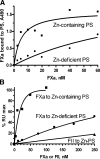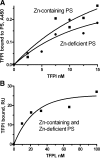Plasma protein S contains zinc essential for efficient activated protein C-independent anticoagulant activity and binding to factor Xa, but not for efficient binding to tissue factor pathway inhibitor
- PMID: 19244162
- PMCID: PMC2704590
- DOI: 10.1096/fj.08-123174
Plasma protein S contains zinc essential for efficient activated protein C-independent anticoagulant activity and binding to factor Xa, but not for efficient binding to tissue factor pathway inhibitor
Abstract
Protein S (PS) is a cofactor for activated protein C (APC), which inactivates coagulation factors (F) Va and VIIIa. Deficiency of protein C or PS is associated with risk of thrombosis. We found that PS also has APC-independent anticoagulant activity (PS-direct) and directly inhibits thrombin generated by FXa/FVa (prothrombinase complex). Here we report that PS contains Zn(2+) that is required for PS-direct and that is lost during certain purification procedures. Immunoaffinity-purified PS contained 1.4 +/- 0.6 Zn(2+)/mol, whereas MonoQ-purified and commercial PS contained 0.15 +/- 0.15 Zn(2+)/mol. This may explain the controversy regarding the validity of PS-direct. Zn(2+) content correlated positively with PS-direct in prothrombinase assays and clotting assays, but APC-cofactor activity of PS was independent of Zn(2+) content. PS-direct and Zn(2+) were restored to inactive PS under mildly denaturing conditions. Conversely, o-phenanthroline reversibly impaired the PS-direct of active PS. Zn(2+)-containing PS bound FXa more efficiently (K(d)(app)=9.3 nM) than Zn(2+)-deficient PS (K(d)(app)=110 nM). PS bound TFPI efficiently, independently of Zn(2+) content (K(d)(app)=21 nM). Antibodies that block PS-direct preferentially recognized Zn(2+)-containing PS, suggesting conformation differences at or near the interface of 2 laminin G-like domains near the PS C terminus. Thus, Zn(2+) is required for PS-direct and efficient FXa binding and may play a role in stabilizing PS conformation.
Figures








Similar articles
-
Zn²(+) -containing protein S inhibits extrinsic factor X-activating complex independently of tissue factor pathway inhibitor.J Thromb Haemost. 2010 Sep;8(9):1976-85. doi: 10.1111/j.1538-7836.2010.03919.x. J Thromb Haemost. 2010. PMID: 20492471 Free PMC article.
-
Activated protein C, protein S, and tissue factor pathway inhibitor cooperate to inhibit thrombin activation.Thromb Res. 2023 Oct;230:84-93. doi: 10.1016/j.thromres.2023.08.012. Epub 2023 Aug 23. Thromb Res. 2023. PMID: 37660436 Free PMC article.
-
Platelet protein S directly inhibits procoagulant activity on platelets and microparticles.Thromb Haemost. 2013 Feb;109(2):229-37. doi: 10.1160/TH12-08-0622. Epub 2012 Dec 13. Thromb Haemost. 2013. PMID: 23238804 Free PMC article.
-
Novel insights into the regulation of coagulation by factor V isoforms, tissue factor pathway inhibitorα, and protein S.J Thromb Haemost. 2017 Jul;15(7):1241-1250. doi: 10.1111/jth.13665. J Thromb Haemost. 2017. PMID: 28671348 Review.
-
Factor V and thrombotic disease: description of a janus-faced protein.Arterioscler Thromb Vasc Biol. 2002 Apr 1;22(4):530-8. doi: 10.1161/01.atv.0000012665.51263.b7. Arterioscler Thromb Vasc Biol. 2002. PMID: 11950687 Review.
Cited by
-
Tissue factor pathway inhibitor: structure-function.Front Biosci (Landmark Ed). 2012 Jan 1;17(1):262-80. doi: 10.2741/3926. Front Biosci (Landmark Ed). 2012. PMID: 22201743 Free PMC article. Review.
-
Zn²(+) -containing protein S inhibits extrinsic factor X-activating complex independently of tissue factor pathway inhibitor.J Thromb Haemost. 2010 Sep;8(9):1976-85. doi: 10.1111/j.1538-7836.2010.03919.x. J Thromb Haemost. 2010. PMID: 20492471 Free PMC article.
-
Antithrombotic activity of protein S infused without activated protein C in a baboon thrombosis model.Thromb Haemost. 2012 Apr;107(4):690-8. doi: 10.1160/TH11-10-0699. Epub 2012 Feb 28. Thromb Haemost. 2012. PMID: 22370911 Free PMC article.
-
Phosphorylation of protein S by platelet kinases enhances its activated protein C cofactor activity.FASEB J. 2013 Jul;27(7):2918-25. doi: 10.1096/fj.12-225961. Epub 2013 Apr 11. FASEB J. 2013. PMID: 23580615 Free PMC article.
-
Lack of protein S in mice causes embryonic lethal coagulopathy and vascular dysgenesis.J Clin Invest. 2009 Oct;119(10):2942-53. doi: 10.1172/JCI39325. J Clin Invest. 2009. PMID: 19729839 Free PMC article.
References
-
- Schwarz H P, Fischer M, Hopmeier P, Batard M A, Griffin J H. Plasma PS deficiency in familial thrombotic disease. Blood. 1984;64:1297–1300. - PubMed
-
- Mahmoodi B K, Brouwer J L, Veeger N J, van der Meer J. Hereditary deficiency of protein C or PS confers increased risk of arterial thromboembolic events at a young age. Circulation. 2008;118:1659–1657. - PubMed
-
- Mahasandana C, Suvatte V, Marlar R A, Manco-Johnson M J, Jacobson L J, Hathaway W E. Neonatal purpura fulminans associated with homozygous PS deficiency [Letter] Lancet. 1990;335:61–62. - PubMed
-
- Walker F J. Regulation of APC by a new protein: a possible function for bovine PS. J Biol Chem. 1980;255:5521–5524. - PubMed
-
- Heeb M J, Mesters R M, Tans G, Rosing J, Griffin J H. Binding of PS to FVa associated with inhibition of prothrombinase that is independent of APC. J Biol Chem. 1993;268:2872–2877. - PubMed
Publication types
MeSH terms
Substances
Grants and funding
LinkOut - more resources
Full Text Sources
Miscellaneous

